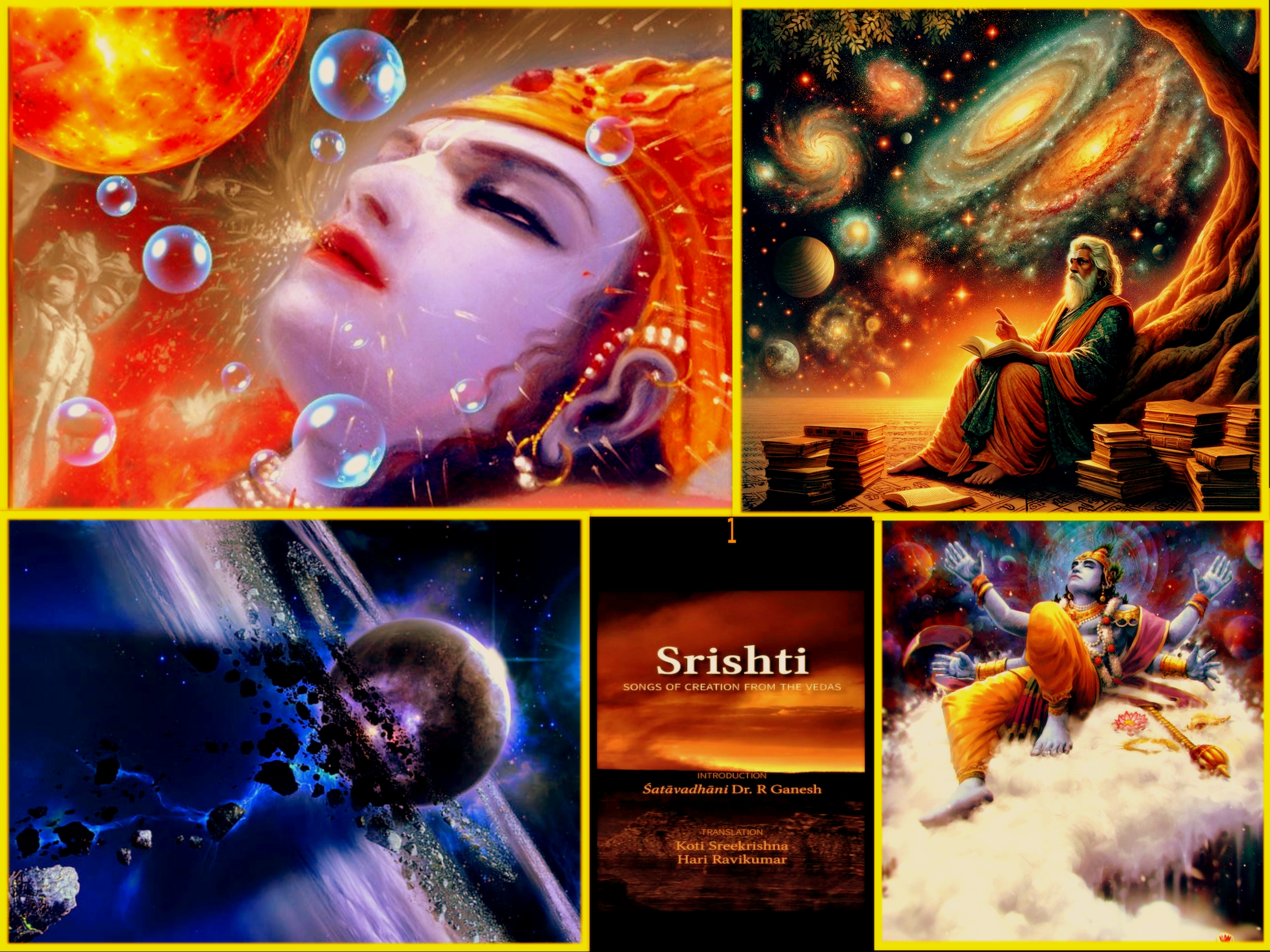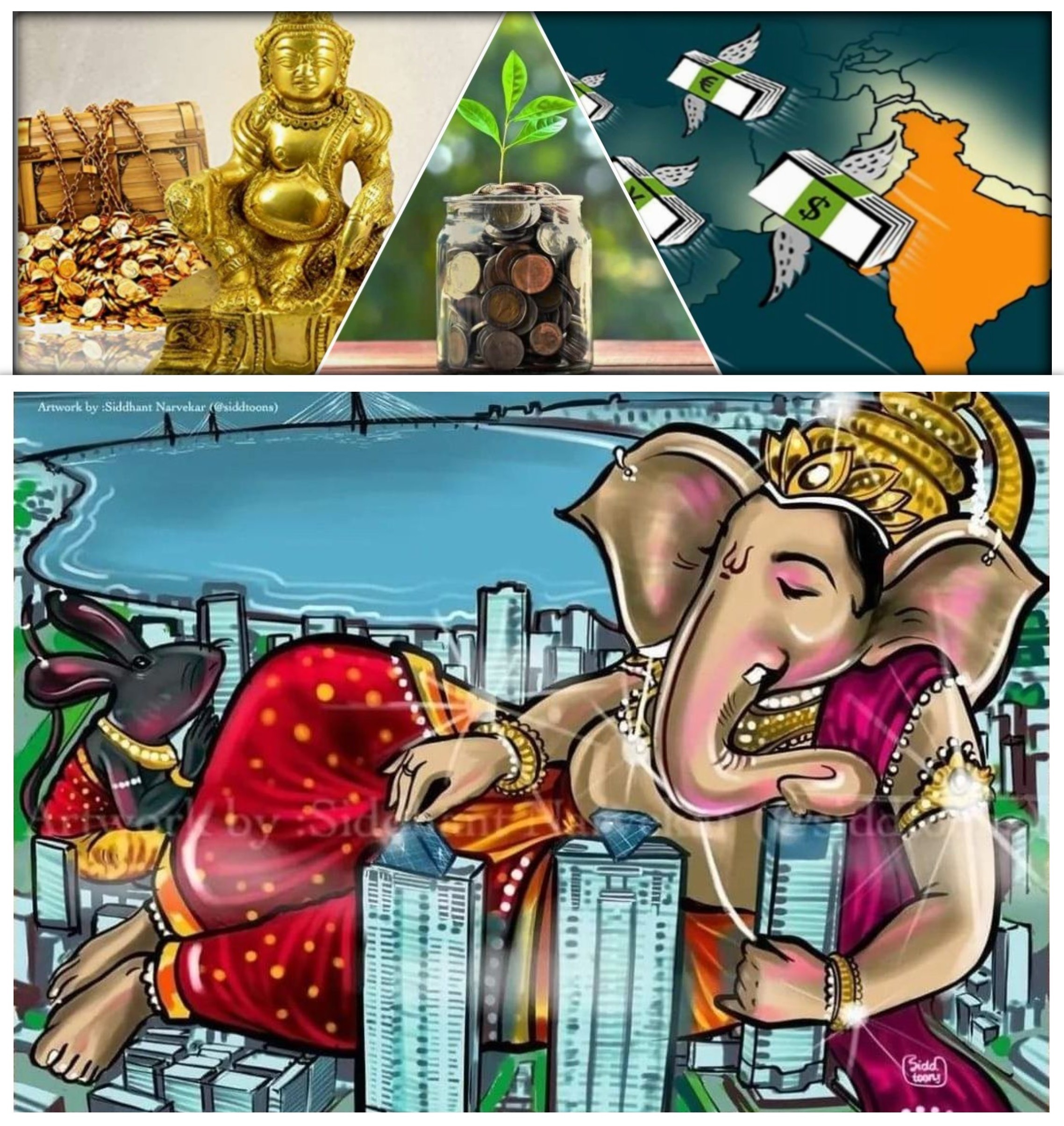- Visitor:267
- Published on: 2024-03-15 06:11 pm
Book Review on Srishti: Songs of Creation from the Vedas
Though the sensitive term “nothingness” comes in the context of Nasadiya sukta and leaves scope for a further prolonged rich debate and understanding, but I think William Shakespeare’s famous phrase “Nothing will come of nothing” aptly applies to the next hymn. This is Purusha Sukta. Remember when Cordelia, who was the younger daughter of King Lear and the only honest and true one of the three refuses to lie unlike her sisters. There Lear replies to her, saying that if she speaks “nothing,” then “nothing” will come to her. And, that is my point. So there must be something… something to give in order to get something.

Book Review on "Srishti: Songs of
Creation from the Vedas" written by Hari Ravikumar and Koti Sreekrishna
Introduction:
Irrespective
of what position you are in your life- a seasoned scholar, a student, a
spiritual seeker or a poetry lover, this book is a rare and must-read
collection, offering a transformative experience that resonates long after the
final hymn is read. The book invites us to start a captivating journey on the
ancient Indic wisdom with profound insights of creation theories within the
Vedic texts. Authored by Hari Ravikumar
and Koti Sreekrishna the paperback
has served as a comprehensive guide to reading some selected but very important
sacred hymns, which specifically focus on creation theories. It must be
remembered that these verses have not only been just a part of our holy
scriptures from antiquity but also forms the foundation of Indic philosophy.
The
book has unlocked a portal to the Vedic era, offering us a glimpse into the
spiritual and philosophical riches embedded in every hymn as chosen by the
authors this time. With thorough care
and expertise, the writers have navigated through the complex verses and
successfully made them accessible to both the experienced and the one who are
new to the Vedic literature. With very clear language and meanings of each and
every important words and sentences, they have translated those hymns. Thus,
placing much easy-to-understand explanations after every poem they have moved
beyond just a mere translation to transforming the verses into lively
experiences.
One
thing I would personally thank Shatavadhani
Dr. R Ganesh about the fact that before jumping directly into the story of complex
verses, he has carefully thrown light and cleared up the basic concepts in the Introduction chapter. This includes an introduction to the Vedic texts with their
origin, chronological understandings, important terminologies, different
concepts, deities associated with Vedas and creation models and last but not
least, the basic philosophical concepts from Vedanta and Puranas. Without
this basic mental preparation, it would have been very difficult this time to
comprehend the various symbolisms explored and dive into the metaphysical
realms, that unravel the multiple layers of difficult meanings embedded in
Vedic shlokas. After that, the writers touched on the ancient cosmological
aspects and timeless truths of the hymns with the proper meaning of the words
applied in those poetries. For this, as mentioned earlier, they have selected
some particular hymns that deal with the current book’s theme i.e. Shrishti or
creation.
Another
thing that I have noticed, rather everyone can see is that there are some
particular hymns that are repeated in many Vedic books. Eg, The Nasadiya sukta, Hiranyagarbha sukta, Purusha sukta,
Viswakarma sukta are there in more than one places like Rig Veda to Krsna
Yajurveda etc, with just slight differences in their content and length. So, at
first, going through the whole book once, I read the book again. The second
time was just for my own interest, but this time it was “sukta”-wise, reading
and comparing each sukta from different chapters.
Nasadiya: The song of the unknown
Rich with so
many exciting creation theories of ancient India (unlike other civilizations)
let’s look at the very first hymn of the Hindus from the book which is the Nasadiya sukta. Well, we who are living
in this era of YouTube and have habits of searching Indic idea-related videos
are well aware of the program- Cosmos: A
Personal Voyage by Carl Sagan, where the prominent scientist utters some
Vedic verses while talking about the timespan of the universe from Hindu
cosmology. Yes, that was from Nasadiya sukta. Again, we 90’s kids can also
recall this hymn chanted in old Doordarshan channel from their show named Bharat Ek Koj. Swami Vivekananda also has his own English translation of the hymn
titled “The Hymn of Creation”.
Though
being same in both places, in the case of Rgveda
Samhita, the seer Paramesthi
Prajapati ends leaving an open-ended question “when God themselves came afterward, who then knows?”[1],
while Taittiriya Brahmana brings the
concept “Brahman” that upholds the
entire creation. Along with that, the latter case includes more words like
divine carpenter, asks existence of forests and kind of trees. The hymn shows the
basic inquisitiveness of human mind. And, this courage to know came not from
any modern advanced man, but someone who was probably no less than about 5000
years before us. Surely, it can’t be denied that our ancestors were really
brave enough when it came to searching for knowledge or, in other words, facing
the truth with a bold heart. Surely, they never ran away from what is truth,
setting aside their personal ego or propaganda which most of us, modern people
are unable to do, despite so much advancement of various knowledge systems. In
Nasadiya sukta they admit their limits of knowledge and kept space for further
information and in this way they successfully reached a certain state of psyche
or consciousness with such poetic beauty and creativity. What an honesty!
While
going through this part of the text, we can see how the ancients have made an
attempt to move beyond the point of singularity. Naturally, there all the
equations of our physics come to cease and then we start asking questions “Now what?”, “Why we are here?”, “Where you
will go?”, “Who created all these?” and so on. Though this is not only the
problem with science, the same issue goes with religion also. They all get
stuck at a certain point and as pushed back, while explaining creation they
avoid the question by words like “God’
will”, “God knows”. But the funny thing is that after the creation comes
into being both science and religion have very clear-cut answers of everything.
So
what were the Vedic Rishi’s answers regarding this? You may say, that to know
what was beyond the veil of existence-non-existence, darkness-light we have to
make intense meditation like what the yogi’s did. But still, I personally have
not become a yogi or reached that state. For now, Nasadiya sukta is significant
for me as a 21st-century Hindu and researcher to understand how our ancients
contemplated the nature of existence, what questions they raised and how they
talks about the ambiguity and mystery of cosmos. Moreover, they have made use
of a very sophisticated dramatic and imaginative language that helps us to
recognize human limits in accepting the world in front. As the book tells us
that we bother about creation since we bother about our existence. When we
repeatedly strive to find the balance between the world and enjoying the world,
we are actually in the process of finding ourselves. And, this is what famous
scientists have always done.
Let’s take the example of Galileo here. He observed the sky with a telescope. He utilized a telescope to observe the sky without conducting experiments or deducing mathematical problems to validate his theory. If this method is deemed scientific, why wouldn't observing the universe through specific spiritual powers be considered scientific as well? Certainly, our ancient seers were not just solely poets but also yogis and no doubt, scientists.
Hiranyagarbha: The Golden Embryo
Next
comes the Hiranyagarbha sukta. This
time, the book picks us up from beyond the boundaries and brings us a step
nearer to the unified field. It talks about a cosmic egg called “Hiranyagarbha”
which is golden and symbolizes potentiality and unity. The idea of golden egg
is also seen in ahoratra of Satapatha Brahmana and Hiranyanda of Chadogya
Upanishad (here, the primordial egg is divided into two parts- silver and
golden). In the latter part of the book the author also mentions about a
Chinese creation story that is an assimilation of aspects of Hiranyagarbha and
Purusha sukta (p 421). But I am still unsure why the
element “gold” is used? It might be because social human beings have a natural
affinity towards gold since it is the most precious and shiny. It is also
associated with money, worth of a person and fortune.
Now,
in this hymn the idea that it was born from water and also water was created
from it can be unclear to anyone. Thanks to Dr. R Ganesh who have already
explained about this as the classical paradox like bija-vrksa-nyaya or the
classical seed-and-tree paradox (pp 45-46). According to him,
the rishis has kept this search open-ended for us to recognize the importance
of mutual nourishing of all beings in the creation process. Also, since the
basic elements of nature like water and others grant us life, so the Hindus
have often found a mix of reverence, admiration and fear towards these
elements, as the authors explained.
The Rig Vedic one is slightly longer than the Tittiriya Samhita’s hiranyagarbha hymn where there are some extra verses and the composer wants the Lord not to harm us and further addresses him to be the creator of truth and harmony also. Another thing that strikes my thought is that there is an offering to be given is talked about to the deity “ka”[2]. The authors mention that this can also mean “to which” as derived from the original word “kasmai” and “ka” is also another name for Prajapati (p 128). While reading the book, I was wondering whether it was somehow related to our Vedic alphabets and as we know that the first letter of our Sanskrit and other Sanskrit derived language’s alphabets starts with “ka”. Is it somehow related this way? Well, I am just speculating.
Koti Sreekrishna
Purusha: The Cosmic Person
Though
the sensitive term “nothingness”
comes in the context of Nasadiya sukta and leaves scope for a further prolonged
rich debate and understanding, but I think William Shakespeare’s famous phrase “Nothing will come of nothing” aptly
applies to the next hymn. This is Purusha
Sukta. Remember when Cordelia, who
was the younger daughter of King Lear
and the only honest and true one of the three refuses to lie unlike her
sisters. There Lear replies to her, saying that if she speaks “nothing,” then “nothing” will come to her. And, that is my point. So there must be
something… something to give in order to get something. Something should be
sacrificed to create something. Keeping
this idea in mind, we now move on to another important and well-liked sukta
from the Vedas. It is also a popular one due to some controversial issues in
Hindu caste system.
Here,
we find the concept of yagna where the primordial man or Purusha is further
sacrificed. Dr. R Ganesh cleared earlier in the book how purusha is not just a
person but that which dwells in the body and connected with fulfillment (p
43). Thus,
purusha is seed of cultivation of the world, he himself is the one sown and
then he himself is reaped. Nonetheless, one should not confuse this Purusha to
be a male component. There are no strict divisions in the Vedas, as the authors
suggest, and they have little to do with gender and sex. Eg. we can take the
Purusha sukta itself where from purusha “virat” is born and from this “virat”
purusha is born. Though virat is a masculine noun, as the authors discuss, but
here it is the female creation principle. In the Vedas, one can find many
complementary concepts that are often associated with male and female
symbolism.
In
the modern lens, while studying ASCII code, this reminds me somehow of author Till
A. Heilmann’s idea of digital ‘reciprocal materiality’ of digital data. He
argues that “It is not only that digital data are always inscribed in some
material substrate (Kirschenbaum’s ‘forensic’ dimension of data); conversely,
the materiality of the medium inscribes itself into the structure of digital
data (its ‘formal’ level). The ‘body of code’ is shaped by the material
framework it inhabits”[3].
To make it simple, this can be easily understood from Mahabharata, where
Shakuntala says that the male enters into the woman and comes out as the son.
So, it is the male who is born again and that is why the wife is addressed as
“jaaya” in India. So wife of any person is also his mother at the same time.
Next,
since this hymn is associated with yajna it gives more curiosity to further
explore the philosophy regarding how yajna and sacrifice i.e. to give away
things selflessly are connected. I have heard that there are many types of
yajnas like rana-yajna or war, ananda-yajna or celebration. This is an
interesting area. But for now, thanks to Dr. R Ganesh again he has cleared the
basics of yajna in this book. The hymn is helpful for me to further explore the
topic. They have noted how yajna is connected with life and various categories
and sub-categories of yajna are there in our scriptures. Another thing to be
noted is where the authors comment, while explaining the hymn that charity
without humility and selflessness is not a real charity.
Most importantly, this sukta is the first to mention about chatur-varna idea of Hinduism from where the controversy of the caste system begins. The Brahmanas are said to be born from the cosmic Purusha’s face, the Kshatriyas from the arms, Vaisyas from his thighs and the Sudras from his feet[4]. The author mentions that this verse indicates that everyone was born sudra and as per their talent and temperament choose to live in other professions. Swami Vivekananda also asserted this. Dr. R Ganesh makes us aware that the root word of varna is vr-varana which means to choose. Maybe as the society gradually became complex, the social structure became more complicated and likewise our understanding of Vedas and its meanings also (pp 34-35).
Shatavadhani Dr. R Ganesh
Other creation hymns and their
signficance
The
rest of the hymns, however, attribute the creation to some “He” or supreme
being. Eg. the srsti chakra sukta is
the finest example. The most interesting fact I found from this hymn is its
reference to Sanskrit syllables. The anushtup meter in which Ramayana,
Mahabharata and Bhagavad Gita are composed is also there in Vedas and is
considered sober and harmonious. The trishtup meter is associated with
Khsatriyas due to its valor and aggressiveness[5].
In
the Viswakarma suktas, though the theme is same, but there are slight
differences in sequences and content found in three places. The most important
teaching here is how we are carried by away by form, diverted from the core
essence of creation due to ego and illusion. This can again become “one” with
the creator through meaning and awareness. Here, a thing that drew my attention
is the line where it is asked where did Viswakarma seat?. This is because the
same thing happens in other religions also where the creator God is said to be
sitting on throne and anti-religious people taunts them by asking who created
the throne or is that God a personal God since He had a body to take sit.
However, the authors in this book mention that in the original verse for
sitting the word adhisthanam is used
(p 93). I won’t deny that adhiṣṭhāna literally
means ‘base, support, substratum’. But it has a much deeper philosophy embedded
in it that striked me. Nonetheless, in Vedānta this specific word is there to
discuss the theory of illusory perception. Particularly, it is applied to
indicate the substratum wherein the illusion occurs. Is it applicable here
also?
Then, in the deva sukta the birth of eight sons of Aditi and the abandoning of the last one somehow reminds me of the birth of Bhisma pitamah in Mahabharata[6]. Furthermore, most of the rest hymns in this book repeatedly deal with the theme of Brahman/Prajapati/primordial Self and Purusha created by Brahman/Prajapati/primordial self like- ukta and parampurusha in Aitareya Brahmana, asana-pipasa in sankhayana aranyaka, asura-praja-deva in Taittiriya Brahmana (it talks about Prajapati only and creation through his tapas not Purusha), brahmanda in Taittiriya Upanishad (it talks about Brahman in everything), agre in Satapatha Brahmana (it speaks about Prajapati and the theme is on fire created by Him), prana in Satapatha Brahmana (Purusha and Prajapati came from prana or breath), prajapati in Satapatha Brahmana, visva purusha of Mundaka Upanishad, sarira sukta of Saunaka Samhita and so on.

Some
hymns that are different
The
agni sukta of Satapatha Brahmana, I found most dramatic, due to its interesting
conversations inside[7]. And,
those who like mathematics must definitely have a quick-look of samvatsara from
Kanva Satapatha Brahmana this time[8].
The aswa and mrityu hymns are around the themes of horse, the kala-sukta talks
about “time” as the generator of everything in the cosmos and om sukta revolves
across the concept of sound, the mantra uttered from Brahman. In the whole
extensive list, the Mithuna hymn from Prasna Upanishad and Manu from Kanva
Satapatha Brahmana are slight different. In the former, one can find a glimpse
of the guru-shishya parampara of ancient India and who a true seeker is. The
latter one demonstrates the story of great flood. Manu remaining the same, the
story is latter associated with Vishnu’s
Matsya-avatara. Similar narrative is also found in many other ancient
cultures. Here, the author mentions that this Manu is not same with the one who
wrote Manusmriti, otherwise I would have been thinking so what we commonly and
wrongly assume to be.
So
keeping all these factors in mind, now, one can understand why the Dr. Koti Sreekrishna mentions in this book
that a Hindu “can be religious and
secular” at the same time with no conflict between science and dharmik
practices. Still having the question whether- is Veda scientific? Most people
will say Veda is religion. However, after reading this book you will not find
any conflict between the symbolism of water theory and shell theory (I am
talking about the Prajapati, cosmic egg concept) with the Darwinian concept and the Big-Bang
theory. Well, I have not touched upon another important recurring theme,
which is the idea of creation coming out of water. This is also there at most
of the cases and for now, I recall one interesting passage from the deva sukta
in this book- where the devas are trying to stand still on the floating water
and however, unable to do so, their movement seemed like dance.
Conclusion:
As
read from the beginning verse of most of these Vedic hymns, I would like to
echo that there was nothing in my mind before getting the book, but there are
lots of things now coming to mind to share after going through the whole text.
Like, there is another recurring important theme, regrettably, that I have not
again discussed is how the supreme being is every time shown as immeasurable
and somehow greater and more extensive than we can imagine through our mere
mind. Once, Swami Samarpananda said that you are truly successful in the area
where your achievements are countless. Eg. if one lies so many times in life
that it is uncountable then he is successful in lying. And, since our supreme
being has endless attributes, there lies His success or “mahima” or glory.
Also,
another thing that comes to my mind is that you can attribute those attributes
to any deity of your choice, but the underpinning philosophy remains the same,
whatever path of Bhakti you take. This book is a very harmonious blending of
ancient thoughts and modern-day scholarly insights. And, in front of the latter
one i.e. the author’s high level of mastery, my review is like a “ucchista” or mere waste or extra of what
they have left for us to think. However, don’t confuse this meaning of
“ucchista” while reading the Ucchista
sukta from the book. There the meaning is very deep and different (p.
340). In
order to transcend the boundaries of time and culture one can try reading this
book, as it has the capacity to make us realize the ancient wisdom, its
significance, the Hindu civilization’s soul and stand in front of the truth
that the Vedic seekers searched for, at least for some time. Hope this book
will help you all in the journey of achieving the greatest enlightenment- as
the apa hymn of Tittariya Aranyaka asserts in its last lines, that those who can
solve the mystery of creation can attain the highest level (p
154).
Om Tat Sat
[1] There was no existence. There
was no non-existence.
No sky above, not a speck that
moved.
What was hidden? Where? What gave
shelter?
And to whom? Was there water,
which was unimaginably deep? (page 65)
[2] Hiranyagarbha arose in the
beginning.
He was the sole lord of all
beings. He supported earth and sky.
We offer our respects to him.
[3] Heilmann,
Till A.. "Reciprocal Materiality And The Body Of Code: A Close Reading of
the American Standard Code for Information Interchange (ASCII)" Digital
Culture & Society, vol. 1, no. 1, 2015, pp. 39-52. https://doi.org/10.14361/dcs-2015-0104
[4] Brāhmaņas came from his mouth, kṣatriyas
came from his arms, vaiśyas came from his thighs, and śūdras were born from his
feet. (p 77)
[5] Gāyatrī became the associate of
Agni. Savită combined with Usnik.
Radiant with chants, Soma combined with
Anustup.
Brhati enhanced the words of
Brhaspati.
Virāt was the glory of Mitra and
Varuna.
Tristup was the share of Indra in
the morning. Jagati entered viśvedevas. This yajña created sages and humans.
[6] Aditi had eight sons who came
from her body.
She went to the gods with seven
of them.
As for Märtända,
she threw him upward.
[7] Prajapati told him, "My
son, you were born after much toil and tapas!
Why do you cry?"
He replied,
"I am not free from evil. I
have not been given a name as yet."
Thus, one should give a name to a
newborn. Then he becomes free from evil.
One can give him a name a second
time, or a third time.
With each name, he becomes free
from evil.
Prajapati said, "You are
Rudra." Since he was given that name, fire took his form.
Since he cried, ‘arodīt’, he is
Rudra.
The boy said, "With this
name, I have become greater. Give me another name
[8] He divided himself into twenty
parts, with each part having 36 bricks. But he did not succeed. He did not try
dividing himself into twenty-one, twenty-two, or twenty-three parts.
He divided himself into
twenty-four parts, with each part having 30 bricks.
He stopped at the fifteenth
division. Since he stopped after fifteen divisions, there are fifteen forms of
the waxing moon and fifteen forms of the waning moon.
Since he divided himself into
twenty-four parts, there are twenty-four fortnights in a year.
His body now consisted of
twenty-four parts with 30 bricks each, but he felt he had not fully developed.
He saw the 15 muhūrtas of the day - represented by the lokampiņā bricks- as
parts of his own body.
So also the 15 muhūrtas of the night. They are
muhūrtas because they 'readily, muhu
protect’, trayante. (p 240)
- 133 min read
- 0
- 0











